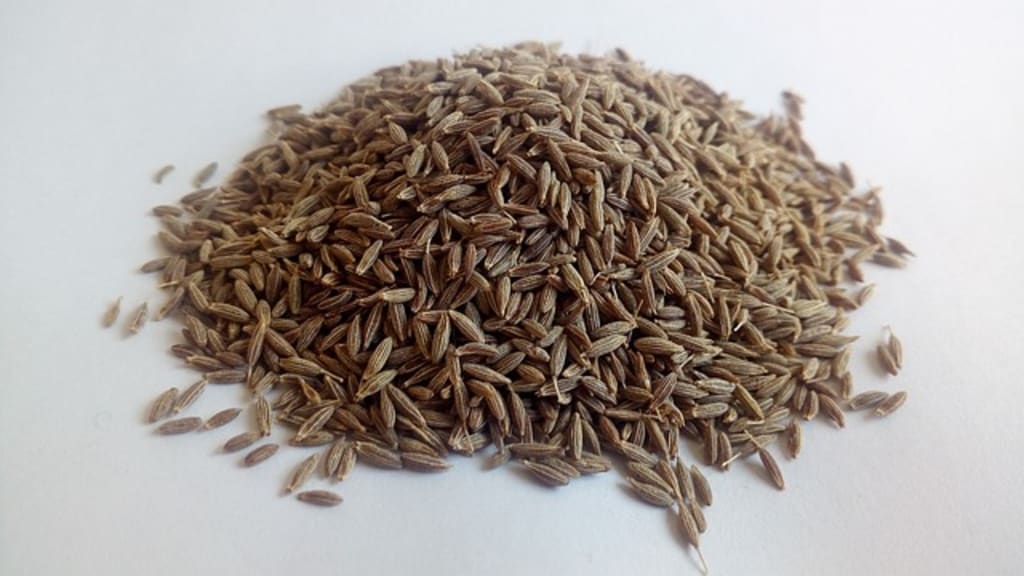Did you know these 5 benefits of cumin?
Health benefits

1.Cumin is beneficial for digestive power.
Cumin is a good source for strengthening the stomach and digestive system. No problems like stomach ache, indigestion, diarrhea, constipation etc due to daily consumption.
Method of use.
Add a teaspoon of roasted cumin powder to a glass of water, mix and drink.
2.Cumin strengthens bones.
Cumin is very useful for calcium deficiency.
Method of use.
Drink a spoonful of cumin powder and pepper along with buttermilk.
3.Benefits of Cumin in Abdominal Pain During Menstruation.
Menstruation is a natural process. In such a situation, women have to experience this unbearable pain every month. During this, they have to face many problems like stomachache, backache, vomiting etc. Cumin is very useful in this.
Method of use.
Mix dill, celery, cumin and fennel in equal amounts. It removes the complaint of constipation. Also, to get relief from stomach ache, roast cumin seeds in a pan and apply cumin seeds on a cotton cloth to shrink the stomach. It provides relief in pain.
4.Cumin is beneficial in enhancing memory
Cumin is very beneficial in boosting memory.
Method of use.
Chew half a teaspoon of cumin every day to increase thinking, understanding and remembering power.
5.Get rid of gas problem with cumin.
When there is gas in the intestines, the sufferer is very upset. In such a situation, use cumin. Cumin relieves abdominal pain and intestinal gas.
Method of use.
Add a pinch of roasted cumin seeds, some ginger, rock salt and half a teaspoon of fennel seeds to a glass of water and boil the water. After straining it can be cooled and drunk.
Nutritional value
In a reference amount of 100 grams (3.5 oz), cumin seeds provide high amounts of the Daily Value for fat (especially monounsaturated fat), protein, and dietary fiber (table). B vitamins, vitamin E, and several dietary minerals, especially iron, magnesium, and manganese, are present in substantial Daily Value amounts.
Cultivation areas
India is the world's largest producer of cumin, accounting for about 70%. The other major cumin-producing countries are Syria (13%), Turkey (5%), UAE (3%), and Iran.ndia produced 856,000 tons of cumin seed in the 2020–2021 fiscal year.
Traditional
India, the seeds are powdered and used in different forms such as kashaya (decoction), arishta (fermented decoction), and vati (tablet/pills), and processed with ghee (a semifluid clarified butter). In traditional medicine practices of several countries, dried cumin seeds are believed to have medicinal purposes,although there is no scientific evidence for any use as a drug or medicine.
Likely originating in Central Asia, Southwestern Asia, or the Eastern Mediterranean, been in use as a spice for thousands of years. of wild cumin were excavated in the now-submerged settlement of Atlit-Yam, dated to the early 6th millennium BC.cavated in Syria were dated to the second millennium e also been reported from several New Kingdom levels of ancient Egyptian archaeological sites.ancient Egyptian civilization, cumin was used as a spice and as a preservative in mummification.
Cumin was a significant spice for the Minoans in ancient Crete. Ideograms for cumin appear in Linear A archive tablets documenting Minoan palace stores during the Late Minoan period.Tient Greeks kept cumin at the dining table in its own container (much as pepper is frequently kept today), and this practice continues in Morocco. Cumin was also used heavily in ancient Roman cuisine.India, it has been used for millennia as a traditional ingredient in innumerable recipes, and forms the basis of many other spice blends.[
Cumin was introduced to the Americas by Spanish and Portuguese colonists. Black and green cumin are used in Persian cuisine. Today, the plant is mostly grown in the Indian subcontinent, Northern Africa, Mexico, Chile, and China. cumin is often used as part of bird food and exported to many countries, the plant can occur as an introduced species in many territories.
About the Creator
Enjoyed the story? Support the Creator.
Subscribe for free to receive all their stories in your feed. You could also pledge your support or give them a one-off tip, letting them know you appreciate their work.





Comments
There are no comments for this story
Be the first to respond and start the conversation.